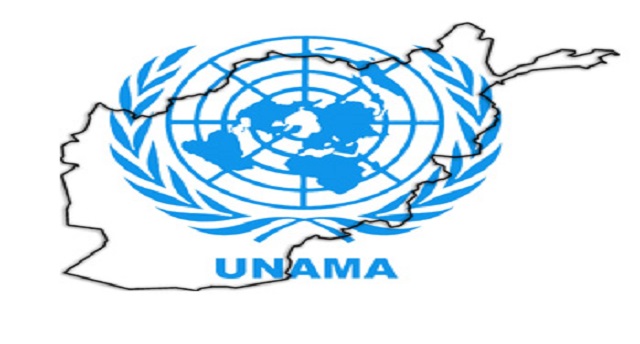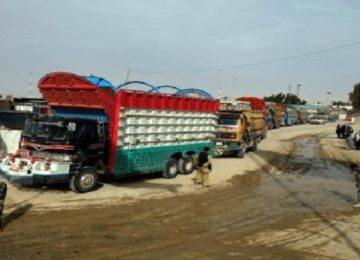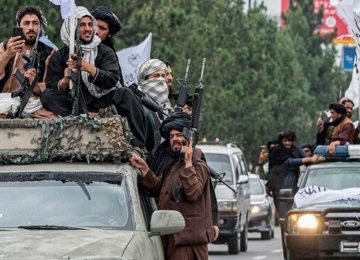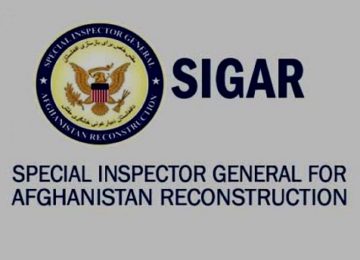October 17, 2019
UNAMA released a special report on Wednesday 9 October, which examines in detail the United States airstrikes against alleged methamphetamine processing facilities in Bakwa district of Farah province. The report concludes that the operation, which took place on 5 May 2019, “did not meet the definition of legitimate military objectives under international law.” It is not clear how many airstrikes the US conducted against alleged drug labs since November 2017 when it began targeting these facilities under the new authorities granted by the Trump Administration’s South Asia strategy. In this dispatch, AAN’s Jelena Bjelica summarises UNAMA’s findings and lays out what we know so far about US airstrikes against alleged drug labs in Afghanistan.
The newly released UNAMA report “Airstrikes on Alleged Drug-Processing Facilities – Farah, 5 May 2019” found that US airstrikes on 60 alleged methamphetamine drug production sites (1) in Farah province and neighbouring Nimroz province on 5 May 2019 caused at least 39 civilian casualties (30 deaths, five injured and four undetermined). The casualties included 14 children and one woman. (2) “Amongst the verified civilian deaths, UNAMA determined that 17 of them – all adult males – were working in the drug labs,” the report said.
UNAMA’s fact-finding mission in Bakwa district of Farah and Delaram district in Nimroz province was carried out on 26 June, together with the Afghanistan Independent Human Rights Commission (AIHRC), and involved 21 face-to-face interviews with individuals and community members who were affected by the airstrikes. The mission received, the report said:
[…] reliable and credible information to substantiate at least a further 37 more civilian casualties (30 deaths and seven injured), including 30 children and two women.
This bring the probable number of civilian casualties as a result of the Bakwa air strikes up to, at least, 76: sixty deaths, twelve injured and four undetermined.
“The 5 May 2019 airstrike operation in Bakwa district,” the report said, “was the first time that UNAMA had received allegations of civilian casualties of such a scale [as a result of anti-drug operations], raising concerns about unprecedented levels of civilian harm resulting from such a type of operation.”
UNAMA’s report said that according to the US the airstrikes targeted methamphetamine production facilities in Bakwa district, which “were controlled and operated exclusively by the Taliban and used to directly fund the Taliban’s war-fighting efforts.”
“According to longstanding United States (US) policy, economic objects that contribute to the war effort of a party to a conflict are considered to be legitimate military objectives,” the UN reports said, adding that the US set out that “comprehensive intelligence confirmed that all personnel inside of the laboratories were Taliban combatants.”
“USFOR-A assessed that there were no civilian casualties resulting from the airstrikes and no women and children were killed or injured during the operation,” the report said.
However, UNAMA findings indicate that “the drug production facilities in Bakwa district were not controlled and operated exclusively by the Taliban, but rather they were owned and operated by criminal groups with connections to international drug trafficking networks.” (3)
“While some of the sites may have been associated with illicit activity, they did not meet the definition of legitimate military objectives under international law,” the UNAMA report said.
The Bakwa airstrikes as reported by survivors
The UNAMA report describes an incident in Shagai village of Bakwa district where according to multiple reliable and credible sources reported, three children were killed when an airstrike impacted their home on 5 May. The report said:
After one strike hit close to the house, the father shouted to his family members to run away from the house before a second bomb was dropped on the house. Three young boys, aged between one and a half to seven years old, were unable to escape in time. UNAMA has verified the death of one of the boys, as well as the injury of another boy around 12 years old who was in a neighbouring house. UNAMA also received specific information about the injury of a girl around four to five years old and a boy around two years old, relating to the same incident, and is seeking to verify the case.
In another incident in the same area, multiple reliable and credible sources reported that 12 members of the same extended family were killed and injured when an airstrike hit their house. UNAMA verified seven civilian deaths (including five children) and three injured civilians (including two children). For two of the children, UNAMA has not yet been able to determine whether their current status is injured or killed as information was received from sources at different points in time.
The report further said:
During the mission to Bakwa district, the fact-finding team visited an impact site where an airstrike on a house resulted in five civilian casualties (three deaths, including two children, and two injured), according to multiple reliable and credible sources. According to witnesses, two aerial strikes were conducted. The first one reportedly damaged the house. A few minutes later when people from the surrounding area gathered to see what had occurred, a second airstrike hit the same location, causing the civilian casualties.
On Wednesday, 9 October, a few hours after UNAMA released the report, the US forces in Afghanistan (USFOR-A) issued a statement denying that the strikes had caused any civilian casualties and insisting that the US had conducted “precision” strikes on what it knew to be Taliban methamphetamine labs (for the full USFOR-A statement see here).
In a tweet accompanying the statement, the spokesman stated that “USFOR-A is deeply concerned by UNAMA’s methods and findings. Sources with limited information, conflicted motives and violent agendas are not credible. USFOR -A follows the highest standards of accuracy and accountability to avoid harm to non-combatants and collateral damage.”
“In addition to imagery collection during the precision strikes, USFOR-A conducted exhaustive assessments of the facilities and surrounding areas after the strikes,” the USFOR-A said in its statement. “Combined assessments determined the strikes did not cause deaths or injuries to non-combatants.”
USFOR-A’s swift dismissal of both UNAMA’s findings and its methodology appears to point to a continued unquestioning reliance on in particular signal and aerial intelligence and information provided by Afghan partners.
US airstrikes on drug labs
The United States have pursued various counter-narcotics approaches in Afghanistan in the 1980s and 1990s, mainly involving passive observation of developments on the ground. Between 2001 and November 2017 these efforts included eradication, interdiction and blacklisting of individuals (see AAN reporting here), next to a ‘soft approach’, such as alternative livelihoods initiatives, good performance initiative, etc.
In November 2017, US escalated its efforts and launched an airstrike campaign to target “Taliban financial networks and revenue streams”, using expanded the targeting authorities provided under President Trump’s new South Asia strategy (see AAN reporting here). This campaign started in Helmand province on 19 and 20 November 2017 when the US and Afghan forces conducted a combined 24-hour operation targeting several alleged Taleban drug labs and one so-called command-and-control node in the north of province. The operation, dubbed “Jagged Knife”, included three airstrikes in Kajaki district, four in Musa Qala district and one in Sangin district. UNAMA verified 10 civilian casualties (one man, three women and six children) in one of the airstrike conducted on 19 November 2017 on buildings in the area of a bazaar in Musa Qala district (where opium was reportedly being traded).
NATO’s Resolute Support Civilian Casualty Mitigation Team in Kabul, however, denied that there had been civilian casualties in the operation and said it had “disproved the allegation as surveillance of the house over a significant period of time showed no sign of the presence of a family.”
It is not clear how many airstrikes in total the US has conducted between November 2017 and October 2019. However, some estimates are available in a Resolute Support April 2018 press release. The press release, for example, said that “the Taliban counter-revenue campaign, which began in November 2017, has continued without pause through the winter” and that US and Afghan defence forces expanded “their counter-revenue efforts against the Taliban beyond Helmand and Southern Afghanistan” to Farah and Nimroz provinces. It also said that: “Overall, since November 2017, the campaign has conducted 75 strikes against narcotics production facilities in Afghanistan.”
In June 2018 at the US Department of Defence press briefing, Brig. Gen. Lance R. Bunch provided a new number when he said:
The entire purpose behind our air campaign is to pressure the Taliban into reconciliation, and help them realize that peace talks are their best option. We kept the pressure on them through the winter and into this spring. Before the recent cease-fire began, Operation Iron Tempest, the name of our air campaign, had destroyed 154 Taliban targets […] includ[ing] narcotics production, storage and trafficking locations, weapons and explosive caches, headquarters and staging areas. […] I also want to point out during these 154 strikes, we have no credible allegations of civilian casualties. Obviously I can’t discuss the specifics of the execution of our operations, but our airstrikes and raids are targeted very specifically in order to avoid civilian casualties while putting maximum financial pressure on the insurgents.
As the US campaign intensified in spring 2018 the Taleban changed their tactics. According to the UNAMA report “towards the end of May 2018, a Taliban commander in Helmand, Mullah Manan, had reportedly ordered all drug labs to move out of urban areas in territory he controlled due to concerns about a rising number of civilians killed from US airstrikes targeting these labs.” The report said that Mullah Manan reportedly stated in his message that “[w]e must strictly explain to people that if they do not stop drugs factories in public houses they will go to jail” and that any Taliban who permitted such facilities would be punished.
The US military approach to counter-narcotics was also questioned by Special Inspector General for Afghanistan Reconstruction (SIGAR) John F. Sopko. In his June 2018 report he expressed concerns over the aerial campaign and its potential impact on civilians:
[T]he longer-term impact of the air interdiction campaign on drug production, insurgent financing, government corruption, and a host of other drug-related challenges remains uncertain. There is also the risk that expanded air strikes by Afghan and international forces could result in civilian deaths, alienate rural populations, and strengthen the insurgency. Civilian casualties – or public perceptions that the bombings were targeting rural communities with few viable income sources – could result in a greater long-term cost to the coalition than the short-term benefit of temporarily disrupting drug production and insurgent financing.
Sopko was also quoted questioning the success of the airstrikes. He said in April 2019, however, that almost all information that would allow for assessing the success of these operation is “now classified or non-existent.”
Anti-drug airstrikes in the light of humanitarian law
Apart from the adverse effects of causing civilian casualties, as pointed out by SIGAR, the airstrikes in themselves appear to go squarely against international humanitarian law. According to the UNAMA report drug labs are not a legitimate military target: “Under international humanitarian law, objects that contribute economically or financially to the war effort of a party to a conflict may not be lawfully made the target of attack on that basis alone as they do not fulfil the definition of a military objective under international humanitarian law.”
The report underlines that international humanitarian law sets out that military objectives are limited to “objects which by their nature, location, purpose or use make an effective contribution to military action and whose total or partial destruction, capture or neutralization in the circumstances ruling at the time, offers a definite military advantage.” With regard to the individuals working in the drug labs, the report finds that “individuals who are supporting an armed opposition group – politically, financially or otherwise – but who do not have a continuous combat function in the organized armed group, are therefore not considered to be members of the armed group.”
Based on these international humanitarian law definitions, UNAMA said it was “not able to corroborate the position of USFOR-A that the locations targeted by the airstrikes constituted legitimate military targets.” It said:
UNAMA found that the civilian structures that were allegedly used as drug labs and were hit during the airstrikes did not have a sufficient nexus to the Taliban’s war-fighting operations to warrant their classification as military objectives. The targeting of the drug labs did not offer a definite military advantage to USFOR-A as the damage caused was mainly financial in nature. Moreover, some of the targeted structures did not appear to have any connections to drug-processing activities, including residential homes.
The civilian status of the individuals affected by the 5 May airstrikes is not in question. Based on information gathered by UNAMA, the personnel working inside the labs were not performing combat functions and were therefore entitled to protection from attack; involvement in illicit drug activity would not qualify as direct participation in hostilities. Furthermore, UNAMA found that while some of the civilians killed or injured in the airstrikes were working in the drug labs, others – including women and children – were not.
USFOR-A in its statement, however, disputed UNAMA’s “narrow definition of legally targetable combatants.”
The authorities provided by the new US South Asia policy are wide ranging and, when used for more aggressive anti-drug targeting, they threaten to be yet another way in which military operations deeply affect the lives and livelihoods of ordinary people. It is troubling that the US military’s response to the corroboration that there were indeed civilian casualties is, again, a blanket denial and an insistence that their intelligence cannot be wrong.
It is equally troubling that the US military will not engage with the argument that their targeting appears to go squarely against humanitarian law. The US’ claim that the targeted facilities were “controlled and operated exclusively by the Taliban” and that thus everybody present in these facilities can be considered a combatant and/or legitimate military target evidently does not hold up in the face of the findings on the ground.
Edited by Martine van Bijlert
(1) Crystal meth, originally a small-scale ‘kitchen lab’ production as AAN reported in 2015, is now being produced on a huge scale, as David Mansfield and Alexander Soderholm have detailed here. There has been “dramatic growth in the methamphetamine industry in Afghanistan,” they write, “fuelled by a ready supply of a homegrown ephedra crop.” Ephedrine is a substance used to produce methamphetamine and can be made from a native plant that is widespread in Afghanistan. The use of the plant is reported to have reduced methamphetamine production costs by half. The plant is reportedly harvested in Ghor and sold to traders from Bakwa and Gulistan in Farah, as well as Delaram in Nimroz.
(2) Since 2009, UNAMA has recorded the following child casualties from airstrikes: 2009 – 152 (92 deaths and 60 injured); 2010 – 48 (27 deaths and 21 injured); 2011 – 183 (127 deaths and 56 injured); 2012 – 74 (51 deaths and 23 injured); 2013 – 49 (35 deaths and 14 injured); 2014 – 54 (32 deaths and 22 injured); 2015 – 91 (36 deaths and 55 injured); 2016 – 200 (78 deaths and 122 injured); 2017 – 266 (114 deaths and 152 injured); 2018 – 492 child casualties (236 deaths and 256 injured).
(3) The Taleban issued two statements in the days following the airstrikes in which they “categorically rejected” that the drug labs were theirs and that those killed were Taleban. “Not a single victim of Farah incident is connected to the Mujahideen or the Islamic Emirate,” the Taleban statement from early May 2019 said. Although the latter claim, that none of the victim was connected to the Taleban, may be a stretch, it is indeed hard to believe that all sixty facilities were controlled and operated purely by Taleban combatants.
By Special Arrangement with AAN.








